Debate rages between biologists and chemists over whether life began on land or under the sea. Rachel Brazil looks at the arguments
The question ‘How did life begin?’ is closely linked to the question ‘Where did life begin?’ Most experts agree over ‘when’: 3.8–4 billion years ago. But there is still no consensus as to the environment that could have fostered this event. Since their discovery, deep sea hydrothermal vents have been suggested as the birthplace of life, particularly alkaline vents, like those found at ‘the Lost City’ field in the mid-Atlantic. But not everyone is convinced that life started in the sea – many say the chemistry just won’t work and are looking for a land-based birthplace. With several hypotheses in play, the race is on to replicate the conditions that allowed life to emerge.
In 1977, the first deep sea hydrothermal vent was discovered in the East Pacific Rise mid-oceanic ridge. Named ‘black smokers’, the vents emit geothermally heated water up to 400°C, with high levels of sulfides that precipitate on contact with the cold ocean to form the black smoke. This was followed in 2000 by the discovery of a new type of alkaline deep sea hydrothermal vent found a little off axis from mid-ocean ridges. The first field, known as the Lost City, was discovered on the sea floor Atlantis Massif mountain in the mid-Atlantic.
The vents are formed by a process known as serpentinization. Seabed rock, in particular olivine (magnesium iron silicate) reacts with water and produces large volumes of hydrogen. In the Lost City, when the warm alkaline fluids (45–90°C and pH 9–11) are mixed with seawater, they create white calcium carbonate chimneys 30–60m tall.
In 1993, before alkaline vents were actually discovered, geochemist Michael Russell from Nasa’s Jet Propulsion Laboratory (JPL) in California, US, suggested a mechanism by which life could have started at such vents.1 His ideas, updated in 2003,2 suggest life came from harnessing the energy gradients that exist when alkaline vent water mixes with more acidic seawater (the early oceans were thought to contain more carbon dioxide than now).
This mirrors the way that cells harness energy. Cells maintain a proton gradient by pumping protons across a membrane to create a charge differential from inside to outside. Known as the proton-motive force, this can be equated to a difference of about 3 pH units. It’s effectively a mechanism to store potential energy and this can then be harnessed when protons are allowed to pass through the membrane to phosphorylate adenosine diphosphate (ADP), making ATP.
Russell’s theory suggests that pores in the hydrothermal vent chimneys provided templates for cells, with the same 3 pH unit difference across the thin mineral walls of the interconnected vent micropores that separate the vent and sea water. This energy, along with catalytic iron nickel sulfide minerals, allowed the reduction of carbon dioxide and production of organic molecules, then self-replicating molecules, and eventually true cells with their own membranes.
Chemical gardens
Chemist Laura Barge, also a research scientist at JPL, is testing this theory using chemical gardens – an experiment you might have carried out at school. Looking at chemical gardens ‘you think its life, but it’s definitely not’, says Barge, who specialises in self-organising chemical systems. The classical chemical garden is formed by adding metal salts to a reactive sodium silicate solution. The metal and silicate anions precipitate to form a gelatinous colloidal semi-permeable membrane enclosing the metal salt. This sets up a concentration gradient which provides the impetus for the growth of hollow plant-like columns.
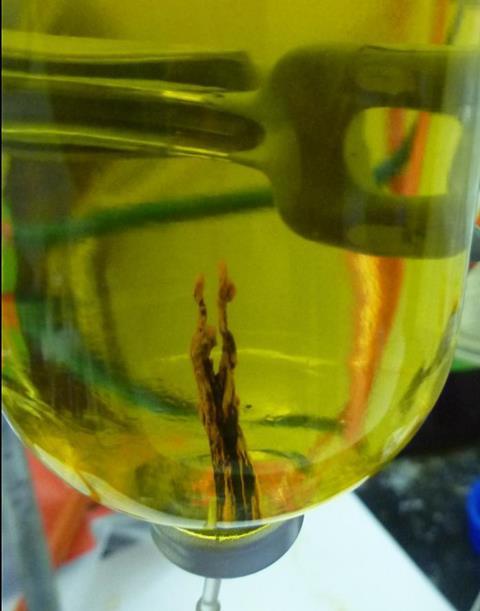
‘We started simulating what you might get with a vent fluid and the ocean and we can grow tiny chimneys – they are essentially like chemical gardens,’ explains Barge. To mimic the early ocean she has injected alkaline solutions into iron-rich acidic solutions, making iron hydroxide and iron sulfide chimneys. From these experiments her team have illustrated that they can generate electricity: just under a volt from four gardens, but enough to power an LED,3 showing that the sort of proton gradients that provide energy in deep sea vents can be replicated.
Nick Lane, a biochemist at University College London in the UK, has also been trying to recreate prebiotic geo-electrochemical systems with his origins of life reactor. He favours Russell’s theory, although is not happy with the ‘metabolism first’ label it is often given, in opposition to the ‘information first’ theory which supposes that synthesising replicating RNA molecules was the first step to life. ‘They are portrayed as being opposing but I think that’s silly,’ says Lane. ‘As I see it, we are trying to work out how you get to a world where you have selection and can give rise to something like nucleotides.’
Lane has been persuaded by how closely the geochemistry and biochemistry align. For example, minerals such as greigite (Fe3S4) are found inside vents and they show some relationships to the iron–sulfur clusters found in microbial enzymes. They could have acted as primitive enzymes for the reduction of carbon dioxide with hydrogen and the formation of organic molecules. ‘There are differences as well, the barriers [between micropores in vent chimneys] are thicker [than cell membranes] and so on, but the analogy is very precise and so the question becomes “Is it feasible for these natural proton gradients to break down the barrier to the reaction between hydrogen and carbon dioxide?”’
Lane’s simple bench-top, open-flow origins of life reactor4 is simulating hydrothermal vent conditions. On one side of a semiconducting iron–nickel–sulfur catalytic barrier, an alkaline fluid is pumped through to simulate vent fluids and on the other side, an acidic solution that simulates sea water. As well as flow rates, the temperatures can be varied on both sides. Across the membrane, ‘The first step is trying to get carbon dioxide to react with hydrogen to make organics, and we seem to be successful in producing formaldehyde in that way,’ says Lane.
So far yields have been very low but Lane considers they have ‘proof of principle’. They are working on replicating their results and proving that the formaldehyde seen is not coming from another source such as degradation of tubing. From the same conditions, Lane says they have also been able to synthesise low yields of sugars, including 0.06% ribose, from formaldehyde, although not at the formaldehyde concentration produced by the reactor alone.
Digging deeper
Investigating hydrothermal vents, geochemist Frieder Klein from Woods Hole Oceanographic Institution in the US has discovered a variation on the deep sea origin story. He has found evidence of life in rock below the sea floor which might have provided the right environment for life to start.

Klein and colleagues were looking at samples from cores drilled from the Iberian continental margin off the coast of Spain and Portugal in 1993. The samples came from rock 760m below the current sea floor, which would have been 65m below the early unsedimented ocean floor. He saw some unusual looking veins in the samples, composed of minerals also found at the Lost City hydrothermal system. ‘That was intriguing to me because this mineral assemblage is only formed when you mix hydrothermal fluids with seawater,’ says Klein. This suggests similar chemistry could be going on below the sea floor.
Within these veins, dated to 120 million years ago, Klein’s team found inclusion of fossilised microbes. He suggests the desiccating properties of the mineral brucite (Mg(OH)2) might explain the preservation of organic molecules from the microbes. These included amino acids, proteins and lipids which were identified by confocal Raman spectroscopy. Klein says he was initially sceptical, but analysis of extracted samples confirmed unique lipid biomarkers for sulfate-reducing bacteria and archaea, which are also found in the Lost City hydrothermal vents system.5 SEM imaging showed carbon inclusions which he says ‘seemed to look like micro-colonies of micro-organisms’
While obviously these samples are much younger, ‘The presence of these microbes is telling us that life is possible in sea floor environments in hydrothermal systems, that were probably present and active throughout most of the early earth,’ Klein observes. ‘The sub-sea floor represents another more protected environment.’
Landlocked
But not everyone agrees that life began in deep sea hydrothermal systems. Armen Mulkidjanian at the University of Osnabruck in Germany says there are several big problems with the idea, one being the relative sodium and potassium ion concentrations found in seawater compared to cells.
Mulkidjanian invokes what he calls the chemistry conservation principle – once established in any environment, organisms will retain and evolve mechanisms to protect their fundamental biochemical architecture. He says therefore it makes no sense for cells that contain 10 times more potassium than sodium to have their origins in seawater, which has 40 times more sodium than potassium. His assumption is that protocells must have evolved in an environment with more potassium than sodium, only developing ion pumps to remove unwanted sodium when their environment changed.
Mulkidjanian thinks life could have sprung from geothermal systems, such as the Siberian Kamchatka geothermal fields in the Russian Far East. ‘We started to look for where we could find conditions with more potassium than sodium and the only things that we found were geothermal systems, particularly where you have vapour coming out of the earth,’ he explains. It is only pools created from vapour vents that have more potassium than sodium; those formed from geothermal liquid vents still have more sodium than potassium. A handful of such system exist today, in Italy, the US and Japan, but Mulkidjanian suggests that on the hotter early earth you would expect many more.
David Deamer of the University of California Santa Cruz in the US has been studying macromolecules and lipid membranes for over 50 years. He comes to the field from a slightly different angle, which some have called ‘membrane first’. But, he says, ‘I’m pretty sure that the best way to understand the origin of life is to realise that it is a system of molecules all of which work together, just as they do in today’s life.’ The location ‘comes down to a plausibility judgement on my part’, he muses.
One of the biggest arguments against a deep sea origin is the fact that so many macromolecules are found in biology. DNA, RNA, proteins and lipids are all polymers and form via condensation reactions. ’You need a fluctuating environment which is sometimes wet and sometimes dry – a wet period so that the components mix and interact and then a dry period so that water is removed and these components can form a polymer,’ says Mulkidjanian. ‘There is no way for this kind of a thing to happen in [a deep sea] hydrothermal vent because you cannot have wet–dry cycles there,’ adds Deamer. Wet and dry cycling occurs every day on continental hydrothermal fields. This allows for concentration of reactants as well as polymerisation.
The assumption that natural selection is incapable over 4 billion years of coming up with an improvement I think is mad
Deamer has been trying to create his own protocells in the lab – by mixing lipids and RNA components adenosine monophosphate and uridine monophosphate. When dried, the lipids self-assemble into membrane-like structures, and if nucleotides are trapped between lipid layers they will undergo esterification to produce RNA-like polymers. Over multiple wet–dry cycles the yield increases to 50%.6
Deamer has confirmed the presence of these polymers inside the ‘protocells’ by direct RNA sequencing techniques. ‘We really do have single-stranded molecules that are in the size range of biological RNA,’ but Deamer cautions that it is not RNA as it is in a biological organism. He created a mixture of RNA, some with phosphate groups bonded as they are in nature, but some bonded ‘unnaturally’, which he concludes then ‘must have been subject to selection and evolution in these little protocells’.
But the deep sea hydrothermal vent camp is not ready to throw in the towel just yet. Barge says the vent environment could allow for concentration of reactants and condensation reactions. ‘You have gels all over the sea floor, you have minerals that absorb things and in the [chimney micropore] membrane itself there are gels, so you can have dehydrating reaction conditions even though the whole system is aqueous.’
Lane also rebuffs the idea that potassium or sodium ion levels might fix future metabolic processes. ‘The assumption that natural selection is incapable over 4 billion years of coming up with an improvement I think is mad,’ explains Lane. ‘In my view, selection drives intracellular ion balance.’ He thinks life would have been quite capable of evolving in a sodium-rich environment and over time developing the ion removal pumps that create the current potassium-rich cells.
Seeing the light
One other point of contention is the presence or absence of ultraviolet (UV) light. This could be a strong influence in a terrestrial origin scenario with no protective ozone layer on the early earth, but completely absent in the deep sea theory. The relative UV stability of RNA nucleotides suggests selection occurred in UV light – on the earth’s surface not in the sea.
This would also support the groundbreaking 2009 synthesis of RNA proposed7 by John Sutherland of the UK’s Medical Research Council Laboratory of Molecular Biology in Cambridge and his 2015 suggested synthesis of nucleic acid precursors starting with just hydrogen cyanide (HCN), hydrogen sulfide (H2S) and UV light.8 Illumination with UV light over 10 days enriched the yields of the biological nucleotides, adding weight to their selection being advantaged in UV light. Mulkidjanian has also suggested zinc sulfide precipitates could have acted as catalysts for carbon dioxide reduction using UV light – an early form of photosynthesis which he calls the ‘zinc world’ scenario
But according to Lane, ‘There is a big problem with life evolving with UV light, which is to say no life today uses UV as an energy source – it tends to destroy molecules rather than promote biochemistry.’ He also argues that the synthetic chemistry proposed in such terrestrial scheme just doesn’t look like life as we know it. ‘It starts with cyanides or with zinc sulfide photosynthesis and you end up with a kind of Frankenstein chemistry,’ Lane says. ‘The chemistry might work but to join that up with life as we know it, I would say is borderline impossible’
Disciplinary divide
Looking closer, the divide between those who support a terrestrial and those supporting an oceanic origin is split between disciplines. Synthetic chemists generally favour a continental origin and geologists and biologist mostly deep-sea hydrothermal vents. Chemists argue it’s impossible to do the chemistry in hydrothermal vents, while biologists argue that the terrestrial chemistry proposed just isn’t like anything seen in biochemistry and doesn’t narrow the gap between geochemistry and biochemistry.
So is there a way to unite the disciplines? ‘At the moment there is not much common ground between these ideas,’ Lane says. Deamer agrees. ‘At this point, all we can say is that everyone has the right to do a plausibility judgement on the basis of their ideas but then they also must do experimental and observational tests.’
The smaller problems will be solvable – that’s what gets me out of bed in the morning
What is needed is that killer piece of evidence or experiment that could join the dots together and explain how and where life began from a prebiotic world. ‘It would really be a big breakthrough if we can find a ribozyme among all of these trillions of random polymers that we are making,’ suggests Deamer. Ribozymes are RNA catalysts that are part of the cell’s protein-synthesis machinery, but are candidates for the first self-replicating molecules.
Further evidence to support the origins of life in deep sea hydrothermal vents centres on showing a plausible set of metabolic steps leading to complex molecules. At JPL, they are looking at how amino acid behave in their chemical gardens, according to Barge. ‘We are working on making an amino acid, and then seeing whether [amino acids] get stuck in the chimneys and whether you can concentrate them and maybe make some peptides.’
‘There are problems and difficulties,’ Lane acknowledges. ‘Can we really make carbon dioxide react with hydrogen to make more complex molecules like amino acids and nucleotides? I’m fairly confident we can do that, but I am aware we have not demonstrated that yet.’ Other difficult questions include whether lipid membranes can be stabilised in seawater with its high calcium and magnesium ion concentrations. But says Lane the big problem of the thermodynamic driving force is solved by hydrothermal vents. ‘Which gives me confidence that the smaller problems will be solvable in that context too, even if they look difficult now – that’s what gets me out of bed in the morning.’
Of course there is one other possibility – that life did not start on earth at all. Panspermia – the theory that life was seeded from space, seems eccentric, but not everybody counts it out. ‘An argument can be made that life actually began on Mars,’ according to Deamer, because it was first to cool down to a temperatures that could support life.
Whether this is the case or not, life elsewhere is certainly feasible. Jupiter’s moon Europa and Saturn’s moon Enceladus are candidates because they both have oceans beneath icy shells. In the next five years, Nasa is planning to send a spaceprobe to both these moons to look for signs of life. Understanding our own origin story could help us work out where to look.
Rachel Brazil is a science writer based in London, UK
References
1 M J Russell, R M Daniel and A J Hall, Terra Nova, 1993, 5, 343 (DOI: 10.1111/j.1365-3121.1993.tb00267.x)
2 W Martin and M J Russell, Philos. Trans. R. Soc. B: Biol. Sci., 2003, 358, 59 (DOI: 10.1098/rstb.2002.1183)
3 L M Barge et al, Angew. Chem. Int. Ed. Engl., 2015, 54, 8184 (DOI: 10.1002/anie.201501663)
4 B Herschy et al, J. Mol. Evol., 2014, 79, 213 (DOI: 10.1007/s00239-014-9658-4)
5 F Klein et al, Proc. Natl Acad. Sci. USA, 2015, 112, 12036 (DOI: 10.1073/pnas.1504674112)
6 L Da Silva, M C Maurel and D Deamer, J. Mol. Evol., 2015, 80, 86 (DOI: 10.1007/s00239-014-9661-9)
7 M W Powner, B Gerland and J D Sutherland, Nature, 2009, 459, 239 (DOI: 10.1038/nature08013)
8 B H Patel et al, Nat. Chem., 2015, 7, 301 (DOI: 10.1038/nchem.2202)
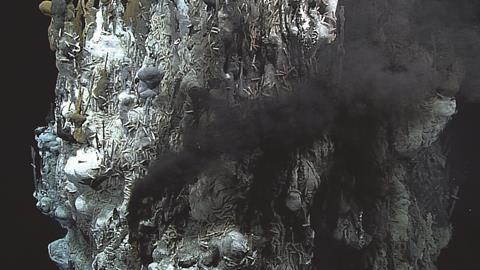

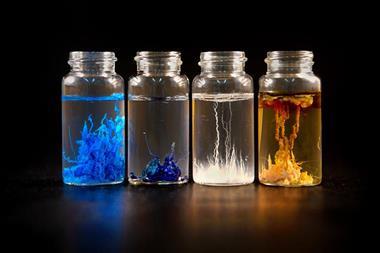
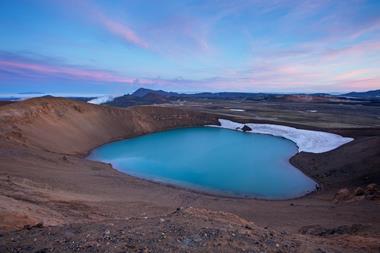


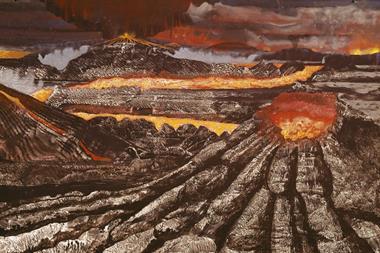






No comments yet